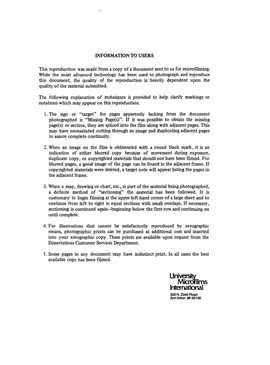| dc.contributor.author | Grau, Harold James, | en_US |
| dc.date.accessioned | 2013-08-16T12:29:22Z | |
| dc.date.available | 2013-08-16T12:29:22Z | |
| dc.date.issued | 1985 | en_US |
| dc.identifier.uri | https://hdl.handle.net/11244/5351 | |
| dc.description.abstract | A series of experiments was performed to investigate various behavioral and neurophysiological aspects of the Novelty Response (NR) of pulse-type weakly electric fish. The NR is a reflexive behavior in which the fish momentarily increases the rate of Electric Organ Discharges (EODs) in response to a novel stimulus. The first set of experiments (Chap.I) examined the effects of stimulus modality and intensity, as well as curariform-drug immobilization on the magnitude and habituation of the NR in three gymnotiform species: Hypopomus artedi, H. occidentalis, and Gymnotus carapo. H. artedi gave higher responses and habituated more slowly to electric and light stimuli than to sound stimuli. H. occidentalis made higher responses and habituated more slowly to electric stimuli than to light or sound stimuli, and G. carapo made higher responses and habituated more slowly to sound stimuli than to electric or light stimuli. All three species habituated to electric stimuli at about the same rates. Stimulus intensity changes and immobilization affected response sizes, but not habituation rates. A series of neurophysiological experiments examined the Torus Semicircularis (TS) and other electrosensory-processing regions of the fish brain, for neural activity that could be associated with the behavioral NR (Chap.II). Event-related potentials (EPs) and single unit recordings indicated that some cells of the TS respond only to electrosensory stimuli that are presented at intervals that are longer than the fish's EOD interval length, i.e., the activity is novelty related. The magnitude of this novelty-related activity in the TS can be correlated with certain features of the behavioral NR, and may represent the activity of electrosensory novelty detectors that are necessary for recognition of sensory changes and the elicitation of the appropriate behavioral response. Bilateral lesions of the Torus Semicircularis (TS) did abolish electrosensory induced NRs, but not those elicited by light or sound stimuli (Chap.III). Gross ablation of the forebrain or the optic tectum of these fish did not eliminate the NR or its habituation. | en_US |
| dc.format.extent | viii, 92 leaves : | en_US |
| dc.subject | Electric organs in fishes | en_US |
| dc.subject | Biology, Neuroscience. | en_US |
| dc.title | The novelty response of pulse-type weakly electric fish : | en_US |
| dc.type | Thesis | en_US |
| dc.thesis.degree | Ph.D. | en_US |
| dc.thesis.degreeDiscipline | Department of Biology | en_US |
| dc.note | Source: Dissertation Abstracts International, Volume: 46-08, Section: B, page: 2577. | en_US |
| ou.identifier | (UMI)AAI8524073 | en_US |
| ou.group | College of Arts and Sciences::Department of Biology | |
